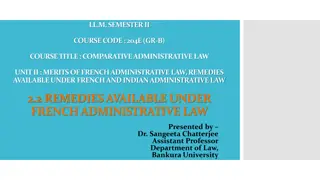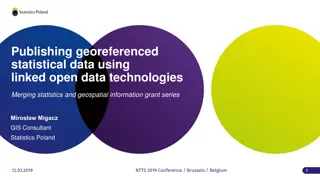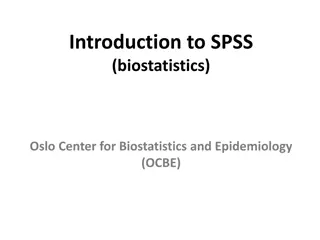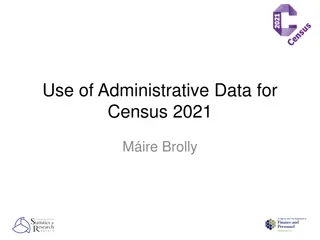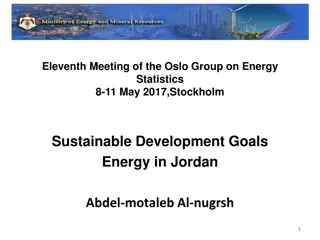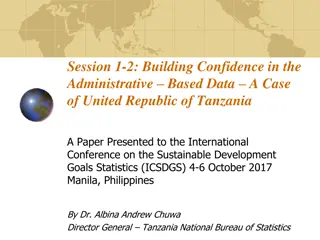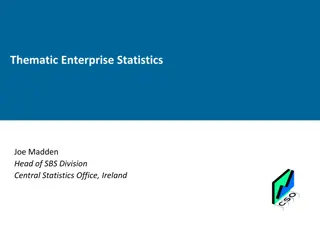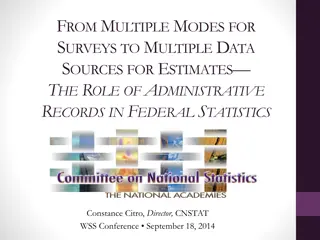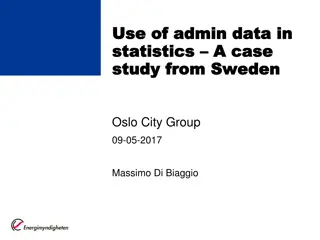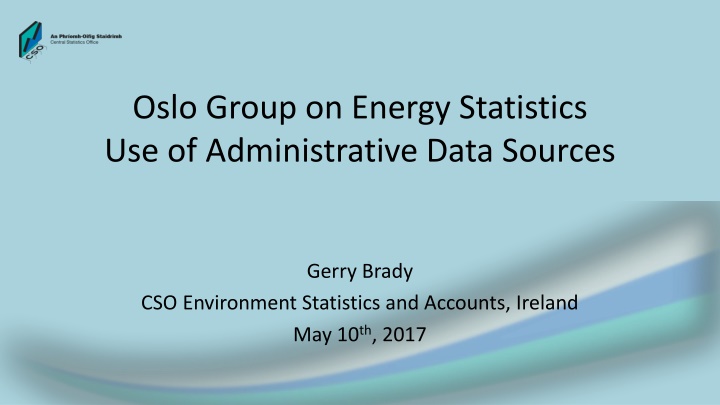
Oslo Group on Energy Statistics Use of Administrative Data Sources
Sustainable Energy Authority of Ireland and Central Statistics Office's involvement in energy statistics compilation. Legal basis, procedures, and advantages of using administrative data in data collection. Overview of presentations and future work discussed in the Oslo Group on Energy Statistics meeting.
Download Presentation

Please find below an Image/Link to download the presentation.
The content on the website is provided AS IS for your information and personal use only. It may not be sold, licensed, or shared on other websites without obtaining consent from the author. If you encounter any issues during the download, it is possible that the publisher has removed the file from their server.
You are allowed to download the files provided on this website for personal or commercial use, subject to the condition that they are used lawfully. All files are the property of their respective owners.
The content on the website is provided AS IS for your information and personal use only. It may not be sold, licensed, or shared on other websites without obtaining consent from the author.
E N D
Presentation Transcript
Oslo Group on Energy Statistics Use of Administrative Data Sources Gerry Brady CSO Environment Statistics and Accounts, Ireland May 10th, 2017
Presentation Structure 1. 2. 3. 4. 5. 6. 7. 8. Overview Legal basis and procedures Business Energy Use survey Energy utilities meter data Building Energy Ratings CSO Household Survey Future work Conclusions 2
1. Overview Sustainable Energy Authority of Ireland is main compiler of energy statistics for Ireland In last five years, Environment Division of Central Statistics Office has slowly become involved Mainly cross-cutting activities rather than direct involvement in data collection for Eurostat Statistical releases based on administrative data Data collection advantage is access to CSO Business Register and ability to conduct and process a survey Weakness is lack of detailed subject-matter knowledge www.cso.ie 3
2. Legal Basis and Procedures Legal basis for access to administrative data is the Statistics Act, 1993 options to request actual or sample microdata file DG issues legal request to data owner Role of Administrative Data Centre Division (ADC) Data protection protocols (source tiers security) http://www.cso.ie/en/aboutus/csodataprotocol/annex1/ Register of data matching projects http://www.cso.ie/en/aboutus/csodataprotocol/csodataprotocolregister/ www.cso.ie 4
Statistics Act, 1993 Section 30 1) For the purpose of assisting the Office in the exercise of its functions under this Act, the Director General may by delivery of a notice request any public authority to - (a) allow officers of statistics at all reasonable times to have access to, inspect and take copies of or extracts from any records in its charge, and (b) provide the Office, if any such officer so requires, with copies or extracts from any such record, and the public authority shall, subject to subsection (2) of this section, comply with any such request free of charge. -> This approach is to get a microdata file www.cso.ie 5
Statistics Act, 1993 Section 31 (1) The Director General may request any public authority to consult and co-operate with him for the purpose of assessing the potential of the records of the authority as a source of statistical information and, where appropriate and practicable, developing its recording methods and systems for statistical purposes, and the public authority shall comply with any such request, in so far as resources permit. -> two-step approach (assess sample before requesting full file) www.cso.ie 6
Administrative Data Centre Coordinates access and management of administrative microdata Most microdata is received directly by ADC and then made available to user areas Access for CSO staff to microdata with personal information is strictly controlled through Privacy Impact Assessment requests ADC makes data available at source tier level (contains identifiers) Access to anonymised data is more straight-forward Anonymised research files can be made available Data protection policies across government departments and agencies are increasingly pro-active often involving obtaining legal advice www.cso.ie 7
3. Business Energy Use survey https://eforms.cso.ie/Public/beu.htm Annual CSO enterprise survey covering both Industry and Services Collects quantity and purchase cost data Survey started in 2009 in a business area with alternating coverage of Industry and Services (twice every 3 years) Environment Division has expanded it to cover all sectors of NACE annually and increased the sample size Supplemented with EPA/SEAI administrative data and CSO data from Industry and Services structural business surveys Response rate of around 65% 8
Business Energy Use Questionnaire 1. 2. 3. 4. 5. 6. 7. 8. 9. Electricity purchased Electricity self-generated Natural gas Petroleum products Road transport Coal Renewable energy and energy from waste Other energy (steam, heat pumps) Heating systems and Air conditioning www.cso.ie 9
www.cso.ie 10
BEU Additional Data EPA Emissions Trading Scheme (fuel quantity by product from licensed local units) specialised returns that are not typical of all enterprises SEAI Large Industry Energy Network (quantity and cost by energy product from enterprises in energy programme) specialised returns SEAI Public Sector Energy Efficiency Programme (quantity by energy product) specialised returns CSO Census of Industrial Production (total fuel costs no quantity) multi-purpose survey from 10+ employees CSO Annual Services Inquiry (total fuel costs no quantity) multi- purpose enterprises with 2+ employees surveyed -> CIP and ASI before 2009 occasionally collected a fuel breakdown www.cso.ie 11
BEU Additional Data continued Additional administrative data has to be matched with CSO Business Register to get NACE codes (no unique identifier to facilitate data matching process but agency identifier so less work for additional years) Objective is to achieve a larger effective sample at NACE Division level Weighted at NACE Division (ETS and LIEN returns set = 1) to get reliable final energy consumption by sector Very important not to give general weights to non-typical returns Imputations needed for energy product distribution and quantity or cost have to be estimated using average prices for Industry and Services sectors www.cso.ie 12
Integrated Data File Number of Returns (excl. sole trader administrative data from ASI) Year BEU ETS LIEN PSEP CIP ASI TOTAL 2009 2,456 27 48 81 4,315 7,953 14,880 2010 1,890 23 54 90 3,506 7,687 13,250 2011 3,276 46 98 81 4,877 6,591 14,969 2012 3,175 22 41 352 3,922 6,740 14,252 2013 3,194 26 44 1,281 4,052 6,591 15,188 www.cso.ie 13
Advantages of Additional Data Availability of high-quality administrative data Create validation bridge between old and new methodologies Increased effective sample size Provide reliable Industry/Services split ETS/Non-ETS estimates Energy sector / Non-Energy sector split Cross-validation between data sources in cases where enterprise is in more than one data source at some stage we will try to exclude enterprises from sample that we will have quantity and cost administrative data for Indicators comparing fuel costs with employment & economic measures www.cso.ie 14
Disadvantages of Additional Data Makes methodology more complex Delays calculation of results as all data sources need to be available and validated CIP and ASI only collect monetary data CSO structural surveys now only collect cost of total fuel purchases so other data and historical data must be of sufficient quality to distribute that by energy product and convert fuel cost data to quantities Danger of double-counting if enterprise is kept from two data sources (different units in Business Register) www.cso.ie 15
4. Energy Utilities Meter Data We obtained mains gas meter consumption data for domestic and non-domestic customers Data are quarterly from 2011 and are geocoded Domestic data will give us an estimate of seasonal space heating for Energy Consumption of Households e.g. Quarter 1 median against Q3 median Non-domestic data has to be matched to CSO Business Register to integrate with survey data Only covers mains gas consumers (on pipeline) www.cso.ie 16
Energy Utilities Meter Data continued Request in for access to electricity meter data No equivalent national utility for oil Working towards bottom-up estimates of energy consumed by households Utility data can indirectly provide indicators of new buildings and of vacant dwellings and holiday homes Utility company may have link to GIS co-ordinates Domestic and non-domestic sectors www.cso.ie 17
Energy Utilities Meter Data continued Spatial, seasonal and time-series dimensions May only cover physical data not monetary Utilities data may not be nationally representative e.g. of rural areas Meter readings may be estimated and subsequently revised (meter reading series could result in negative consumption if earlier reading too high) Census of Population could be used to weight the data e.g. under assumption that households with oil central heating are using same amounts of heat as gas central heating households with similar characteristics (number of occupants, dwelling type, etc.) www.cso.ie 18
5. Building Energy Ratings Covers domestic and non-domestic sectors http://www.seai.ie/Your_Building/BER/National_BER_Research_Tool/ Very detailed energy audits and household construction data EU Energy Performance of Buildings Directive Few other datasets on non-domestic buildings Dwellings with better ratings can achieve a sale or rental premium CSO publishes the data quarterly http://www.cso.ie/en/releasesandpublications/er/dber/domesticbuilding energyratingsquarter12017/ www.cso.ie 19
EPBD Legislation Energy Performance of Buildings Directive (EPBD), 2002/2010 Required all EU Member States to introduce energy certification schemes for buildings Obliges that when buildings are constructed, sold or rented out an energy performance certificate is made available to the owner or by the owner to the prospective buyer or tenant Transposed into Irish law from 2006 onwards Could be basis for EU-wide statistics? www.cso.ie 20
www.cso.ie 21
www.cso.ie 22
www.cso.ie 23
6. CSO Household Survey Conducted as an environment module added on to quarterly household survey Module questions developed by project group that included Environment and Energy agencies Focused on energy use and waste management Sample of 13,000 households Data can be cross-classified by main survey variables Sample weighted to national level and results classified by household characteristics http://www.cso.ie/en/releasesandpublications/er/q-env/qnhsenvironmentmoduleq22014/ www.cso.ie 24
www.cso.ie 25
7. Future Work (sometime) Road transport use is an important statistical data gap Combine CSO business register with vehicle register and vehicle test data -> NACE data by kilometres travelled and vehicle characteristics (fuel type, vehicle type and age, emissions test results) Households consumption of home heating oils (suppliers are private companies rather than public utility) On social side: connect household socio-economic data with energy efficiency data www.cso.ie 26
8. Conclusions An administrative data source can be much more complete than a survey e.g. 750,000 gas meters Once data flow is established may not require large staff input to obtain more data Data may not be nationally representative Data linking may involve a jigsaw of combining inconsistent data variables and coverage Data may need to be manually matched to business register Other areas of office may find the administrative data useful e.g. number of vacant households, house price indices www.cso.ie 27
Conclusions continued As more administrative microdata are obtained, the procedures to manage and protect the microdata should become more formal Data protection concerns and obligations of data owners have increased Data Protection Commissioners more proactive CSO established a dedicated Division to ensure a consistent office-wide approach to obtaining and using microdata Ideally data provider wants something back! www.cso.ie 28







